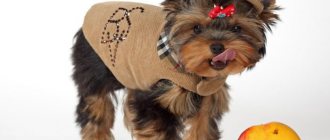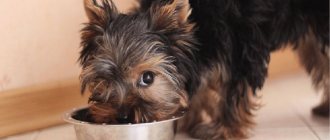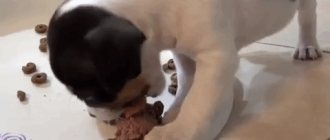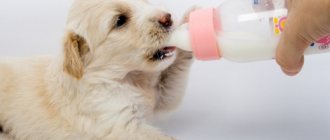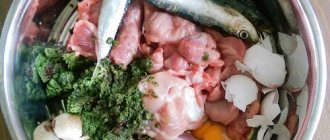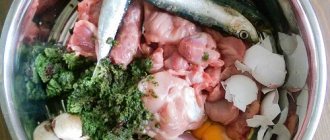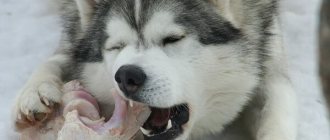Genetic characteristics of the health of mongrels
Every potential owner who decides to get a mongrel dog agrees to a kind of “lottery”. The main advantage is the genetic characteristics of the health of mongrels, but this does not mean that outbred dogs do not get sick or can get by with poor quality nutrition. Potentially, mongrel dogs are healthier, smarter and more comfortable because they instinctively adapt to their owner's needs.
The diet for a dog should be compiled as individually as possible, since outbred dogs can inherit the not very “successful” genes of some ancestors.
The statements below are myths and are spread by illiterate people:
Statistics reveal a number of facts about the health of mongrel dogs:
When preparing a diet for a mongrel dog, you need to take into account its past. It is important not only to choose a high-quality diet, but also to correctly calculate the daily food intake. Practice shows that dogs that were once hungry are prone to overeating, even when they are pets and not deprived of anything.
Water in a puppy's diet
Water is the “fuel” of metabolism. With a lack of fluid in the body, the dog's blood thickens. With a natural type of feeding, the daily water intake is calculated from the ratio of 50 ml per 100 g. body weight.
Industrial foods contain preservatives and even if they are natural, the dog’s need for water increases. When feeding dry food, the daily water intake is at least doubled. When preparing a diet of predominantly wet, canned food, the daily water intake is increased by 25–50%.
Choosing a place and utensils for feeding the puppy
The choice of place and utensils plays an important role, especially in the first days of the puppy’s stay in the new home. It is important that the pet can eat food calmly, leisurely, without feeling competition.
It is almost impossible to guess what size an adult mongrel will be. Small puppies often grow into medium-sized dogs. If the weight of a 2-3 month old puppy does not exceed 4-5 kg, most likely it is a small dog and you don’t need to buy a stand for bowls.
For larger dogs, it is better to immediately purchase a stand and adjust it as they grow. For small dogs, it is better to purchase ceramic or glass bowls, as they are heavier and hardly slip.
The volume of the drinking bowl must be selected according to the size of the dog. If your pet is large, a good quality plastic bowl or small bucket will do. For medium and small dogs, choose a bowl that is convenient in size.
For the safety of your pet and your comfort, the eating area should be covered with a thick, rubberized mat. The puppy will not slip on the rubber surface, even if it spills water. In addition, the mat is easy to wash.
Source
What and how to properly feed your dog natural food
Every dog owner invariably faces the question: what to feed his four-legged pet? Some are inclined to choose dry diets or canned food.
This solution is convenient for the owner. After all, you don’t need to waste time choosing products, as well as preparing nutritious food. But many breeders prefer a natural diet.
Let's look at what feeding principles are recommended by veterinarians in this case. We will also analyze which products are suitable for your pet and what proportion you need to introduce them into the daily diet.
Content:
Basic rules for feeding a dog
Veterinarians remind that dry food and natural products should not be mixed.
Constant use of granules or canned food leads to a decrease in the amount of enzymes produced by the pancreas. Therefore, a sudden transition to natural food will be a serious burden on the dog’s gastrointestinal tract.
Most of the food is not digested and the risk of putrefactive processes in the intestines increases. Unfavorable aspects can also include the development of gastritis, flatulence and other unpleasant conditions.
Having abandoned the idea of mixing dry and natural food in the diet, owners will also have to learn another important point.
Porridge with a small bone cannot be considered a balanced natural food!
In addition to carbohydrates and fiber, the animal's diet should include vitamins and minerals, a sufficient amount of protein and fat. That is why a balanced diet with natural food is much more difficult than with ready-made diets.
Veterinarians recommend following a few simple rules when eating a natural diet:
This is important: For owners who do not have experience in preparing a balanced diet, the best solution would be to consult a veterinarian.
He will help you choose the right type of feeding, recommend the most suitable products, and also help you calculate their daily intake, taking into account the physiological state of the pet, its activity and other factors.
We study the “materiel parts”
A dog is a carnivore and has the appropriate structure of teeth, stomach, intestines, and specific enzymes of the digestive tract, therefore, first of all, it needs to receive animal protein in sufficient quantities.
That is, no matter what feeding method is chosen, the majority of the diet should be meat. However, the balance of all necessary nutrients and vitamins must also be maintained; it is important to remember that treating diseases caused by a deficiency of certain elements is much more difficult than preventing them. Feeding any dog largely depends on its age, size and activity. Indicators of an animal's health, which directly depends on the quality of its feeding, are: good general health, activity, good condition of teeth and coat, uninterrupted functioning of the gastrointestinal tract.
The drinking regime plays a big role in how to properly feed a dog; it must be observed with any method of feeding. Water, firstly, must be available around the clock, and secondly, it must always be fresh, for this it must be constantly changed. The fact is that when a dog drinks, drool and food debris inevitably get into the water, which makes the liquid cloudy and causes pathogenic bacteria to multiply in it, which can cause diseases.
It is especially important to ensure that your dog gets enough fluids when feeding dry food. While natural food and canned food contain moisture, dry food contains almost none, so the owner must take special care to ensure that the pet has free access to water.
How much food should you give your dog?
How to choose the ideal amount of food for your dog? It is necessary to consult with a specialist or carefully observe the behavior of the animal at the time of feeding.
If the dog quickly eats the offered amount of food and the bowl remains clean, then at the next feeding you can slightly increase the portion. If after 15-20 minutes some of the food remains in the bowl, then the next portion should be slightly reduced.
This is important: You should carefully monitor your four-legged friend. Many individuals are prone to gluttony. The result is excess weight, which negatively affects the state of the cardiovascular, musculoskeletal and other systems.
If you gain extra pounds, you should increase your dog’s physical activity and reduce the portion.
What to feed your dog
Creating a balanced diet for your four-legged friend is not as difficult as it might seem at first glance.
This is important: Veterinarians remind us that we should not go to extremes and sometimes be afraid to slightly change the ratio of products.
For example, one day you can give up dairy products in favor of meat by-products. Or reduce the amount of vegetables in favor of increasing the portion of cottage cheese or kefir.
Approximate daily diet for a dog
Creating a balanced diet for a dog is not as difficult as it might seem at first glance. Let's look at what a sample menu for a four-legged pet looks like.
Morning feeding
The ideal solution would be fermented milk products (yogurt, fermented baked milk, kefir, cottage cheese or sour cream) combined with a small amount of porridge. Be sure to add vegetables to the finished porridge.
Evening feeding
Porridge with meat broth, as well as the daily allowance of meat. Additionally, you can give your pet vegetables or fruits. Meat should be replaced with fish 1-2 times a week.
Also, boiled chicken eggs (1 piece each) should be added to the evening feeding a couple of times a week. Or raw quail (3-4 pieces each).
This is important: Veterinarians recommend not mixing meat and dairy products in one feeding. And also do not give fish and meat at the same time.
Sample menu by age
If the puppy was picked up from the street and its age is unknown, offer milk. Next, you can cook liquid semolina porridge and mix in minced meat or egg. You can tell by the puppy's appetite how long he hasn't eaten. Initially, do not give too much 1 tbsp. a spoon will be enough. If the puppy is looking for food, offer more, but only after 1-1.5 hours.
If the age is known, feeding will have its own nuances. This is due to the fact that we do not know what size an adult dog will be. However, careful monitoring of appetite, weighing and measurements will help to predict the future size by 3-4 months.
Up to a month
The female must independently feed the puppies for up to a month. However, if there are many puppies, or the lack of milk does not allow this, complementary feeding is carried out. As complementary foods, you can use milk substitutes purchased at a pet store or cow's milk with the addition of raw chicken egg yolk and sugar.
Up to 2 weeks of age, puppies suckle from their mother up to 12 times a day, up to 3 weeks of age they suckle 10 times, and up to a month the frequency decreases to 6. You also need to feed the puppies using mother's milk substitutes.
At 3 weeks of age you can start complementary feeding using:
- cottage cheese diluted with milk - 20-30 ml;
- yogurt - 15-20 ml;
- egg - ½ pcs.;
- minced boiled meat diluted with broth until mushy, 15-20 ml;
- minced boiled fish, diluted to a porridge, 15-20 ml.
If the puppy is full, he will refuse excess food. If the prescribed dose is not enough, add 5-6 g of butter or no more than a teaspoon of sour cream to the food.
1 month
If complementary feeding has not been done before this age, then it’s time to start. Do not introduce all foods at the same time. Add them to the diet gradually, while identifying what the puppy likes best. This does not mean that you need to feed only what you like, but knowing your preferences, you can combine “dishes”.
From the age of one month, you can include all the products listed above according to the following approximate standards:
- fermented milk cheese (freshly prepared cottage cheese) - 20-25 g;
- fresh yogurt or kefir - 20-30 g;
- minced meat from boiled meat and boiled offal - 20-30 g;
- raw chicken egg - 1/2 pcs.;
- bones (scapula);
- cow's milk - 50-60 g.
When starting feeding approximately, pay close attention to how much the puppy eats. Even a dose of food will help you guess whether the mongrel will be a large dog or a miniature one. Feeding frequency 4 times a day. If your puppy is looking for food, add fatty meats or sour cream to the diet.
2 months
At this age, 4 feedings a day are recommended. The daily ration should not exceed 200 g. If there is not enough food, increase the calorie content by introducing a fatty product, but not carbohydrates.
At this age, the following feed standards are required:
- cottage cheese - 40 g;
- medium fat kefir or yogurt - 40 g;
- minced meat or sea fish (boiled) - 40 g;
- raw meat - 40 g;
- raw egg - 1 piece;
- bones.
3 months
You can feed a puppy at this age 3 times.
Approximate feeding rates may be:
- fermented milk cheese, fresh (not low-fat) - 50 g;
- yogurt or kefir - 50 g;
- boiled meat, offal and sea fish - up to 70 g;
- raw meat - 50 g;
- raw egg - 1 pc.;
- bones.
4 – 6 months
A grown puppy can already feed 2-3 times.
The approximate standards are:
- fermented milk cheese - 60 g;
- yogurt or kefir - 60 g;
- meat, offal or boiled sea fish - up to 100 g;
- raw meat - 60 g;
- raw egg - 1 pc.;
- bones.
From 6 months to 1 year
At this age, the puppy is active and continues to grow. You can already see what size the adult will be. If the mongrel is small, then you can feed it on the previous diet. If the size is impressive, then you need to add food.
You can add porridge (barley, rice, buckwheat) to the boiled offal, but not more than 100 g per day. To increase the energy value, internal pork and beef fat is added to the mixture.
The frequency of feeding is 2 times a day. An approximate diet consists of the following foods:
- boiled offal - up to 100 g mixed with cereal porridge or potatoes;
- fermented milk cheese up to 100 g;
- curdled milk 200 g;
- raw chicken egg 1 pc.;
- bones.
Useful tips
If your dog flatly refuses to eat fresh vegetables, then you can use a little trick. Lightly boiled or stewed vegetables may be to the taste of a picky four-legged pet.
Dog handlers advise excluding sweet, smoked, spicy, and salty foods from your pet’s diet. And under no circumstances should you mix natural menus and ready-made diets.
If absolutely necessary, the transition should be gradual so that the dog’s body can adapt. The duration of adaptation cannot be less than 14 days.
Prohibited Products
It is important to exclude prohibited foods from the mongrel puppy’s diet:
- Products containing sugar or its substitutes, xylitol, flour or yeast, caffeine, cocoa, marinades, salt, spices.
- Bones, pure fat, skin, especially poultry.
- Palm oil.
- Grapes, raisins.
- Soybeans and beans.
- Mushrooms.
- Corn and semolina.
- Raw freshwater fish.
- Dry, salted fish.
- Smoked products, including sausages, balyki, fish.
- Expired products.
- Cat food.
- Leftovers from the table.
Controversial foods in the diet of a mongrel puppy are:
- Lean raw pork - can only be given in cooked form.
- Raw ocean fish – it is advisable to completely exclude it or give it only in cooked form.
- Whole milk – 40% of adult dogs are lactose intolerant.
- Honey - can cause allergies.
- Chicken eggs - when consumed in large quantities, cause allergies.
- Raw and boiled chicken liver in large quantities causes diarrhea or constipation (respectively).
Controversial products can and should be given to a mongrel puppy if an allergic or other acute reaction does not occur after taking them.
What to feed a mongrel puppy?
As soon as a furry four-legged friend appears in the house, the owner immediately faces the question of what to feed the pet. Today, many manufacturers offer a wide variety of dry food, food with added meat and canned food.
However, most people are supporters of natural food and prefer to feed their pets cereals, meat and vegetables.
What to feed the dog is solely up to the owner, but he needs to remember that under no circumstances should you mix food and natural food. The pet's diet should contain either artificial food or natural food.
Conclusion
Natural nutrition is as close as possible to the dog’s diet in its natural habitat. Therefore, if you have the time and desire, you can always create a balanced and healthy diet for your pet, which will be the key to your dog’s health and longevity.
By the way, if you decide to switch your pet from natural feeding to dry food, you need to do this gradually, over 10-14 days. At the same time, during the transition period, probiotics should be added to the dog’s diet daily.
What to feed a simple mongrel?
I have a mongrel, although it’s a cross with a shepherd, so she’s quite large in size. Considering the large size of my dog, I can’t feed her only meat and so on.
I think that such food will not harm your dog. Chopped meat, various millet, inexpensive pasta, plus minced meat for animals (for us it costs about half a dollar). Everything is cooked, mixed well and the dog eats. Sometimes minced meat can be replaced with blood sausage.
And the strangest thing is that they bought food, special bones with vitamins, but she doesn’t eat them.
The same as other guard dogs.
meat trimmings large bones bone meal fats
The main thing is not to give food the same way for months.
I fed my mongrel the same thing that we ourselves often ate... it’s just that the borscht was selected for her before adding spices to it.
If you really care about your dog's health, you shouldn't feed it the same thing that you eat yourself. The dog's body is not able to digest and assimilate human food without negative consequences.
The basis of nutrition should be protein foods of animal origin - lean meat (including poultry) of any kind (may contain some cartilage and tendons), except pork! Some of the meat can be replaced with offal - heart, kidneys (first soak in water for at least 30 minutes), liver, spleen (in small quantities), stomach, lung, esophagus, trachea, lips, ears, heads, legs. You can give raw bones 2-3 times a week, but not tubular ones (this is very dangerous)!
Also, part of the meat can be replaced with fish - mackerel, horse mackerel.
Eggs - 2-3 pcs. in Week.
Dairy products - milk (you can try, but in 50% of adult animals it may not be digested and cause diarrhea), low-fat fermented milk products - cottage cheese, kefir.
Grain feed - rice, buckwheat, rolled oats, wheat flakes, pasta, bread, crackers.
Raw vegetables (washed and chopped) - carrots, parsley. Onions and garlic - no more than 10-15 g (may cause negative effects)! Potatoes, turnips, and cabbage are poorly digestible.
Dry food: pros and cons
Dry food for an adult dog or a small puppy is the choice of those owners who either do not know about the existence of natural food, or believe that it is too expensive, difficult to prepare or inconvenient (which, of course, is not entirely true).
It’s interesting that not so long ago, just 30-40 years ago in Russia, they didn’t know about dry dog food at all, and large manufacturers had to popularize it, explaining to dog owners that it would ease their daily (or weekly) torment of preparing porridge with vegetables and meat. They managed to break the consciousness of dog owners, and dry food became a permanent part of the dog’s diet. Now this is a simple and understandable choice, but it does not always correspond to the real health condition or needs of the dog. Dry food often contains more grain ingredients than meat or by-products, and the amount of bone meal and starch exceeds all limits allowed according to the norms of content in a dog’s diet. A dog is a predator, and feeding it cereals and vegetables, even with the addition of bone meal and a small amount of poultry (or fish, or beef, but not all at once) is not the best option.
Imagine that at home every day you eat, for example, millet porridge - a whole bowl of millet porridge, and it comes with a large potato, or even two, and somewhere on the edge of the bowl lies a tiny piece of chicken. And so - every day, from month to month, from year to year, two or three times a day. It gets boring to death, doesn't it? And you are not a predator, you are an omnivore, you can somehow come to terms with such a diet. But a dog - no, he cannot, because his predatory body requires variety, not based on an abundance of grains, but built on meat, poultry, fish or offal with the addition (only addition!) of vegetables and cereals.
Dry food spoils the dog's digestion, it begins to feel unwell, the coat becomes brittle and dull, allergies, obesity, and pathologies of various organs appear. And the statements of some manufacturers and veterinarians that dry food is balanced and specially created for your dog’s health are more of a publicity stunt than the truth. Yes, vitamins and minerals are added to the food, however, in natural food, due to the variety of meat components, the dog receives many times more of the substances it needs than from dry food.
And sick or malnourished dogs often refuse dry food in general, because they cannot eat monotonous food, they vitally need a truly balanced and suitable diet for their species - the dog literally intuitively feels this and refuses dry food, even if he had eaten it before with visible pleasure.
Recommendations for choosing dog food:
1. Consider the age and size of the dog.
All foods have labels indicating what type of animal the particular product is intended for. For example, there are special foods for puppies, for pregnant and lactating dogs, for animals after sterilization, castration, etc. 2. Carefully study the composition of the food. Perhaps some ingredients are contraindicated specifically for your animal. 3. Pay attention to the date of manufacture, expiration date and storage rules for the food. It is unacceptable to give your pet an expired product. Experienced breeders and veterinarians recommend choosing premium, super-premium or holistic food for pet dogs that has a balanced composition that is beneficial for the animal’s body.
Eating natural products
For many owners, the optimal solution is to choose natural products to feed their dog. When determining this type of nutrition, you need to immediately calculate the required daily portion for the animal, taking into account its age and breed. It is important to remember that the products served must contain all the necessary vitamins, minerals and other beneficial microelements in the correct ratio. If you have difficulty calculating your diet, consult an experienced veterinarian.
Pros of natural feeding:
1. The owner can independently choose quality products for the dog.
2. It becomes possible to completely eliminate unsafe additives, dyes, chemical elements and preservatives from the dog’s diet, which will undoubtedly benefit its body and eliminate the risks of developing various diseases. 3. If a dog is allergic to a specific food product, it can be quickly removed from the menu and replaced with an alternative product that does not cause such reactions. 4. High-quality nutrition with natural products will ensure healthy functioning of the digestive tract. Natural food for dogs involves preparing individual meals for your pet from high-quality and fresh food. It is unacceptable to cook a week ahead. Food must be fresh. Food is served to the animal exclusively warm (not hot, but not cold either).
Mixed feeding
Some owners choose to feed their dogs a mixed diet, which involves a combination of dry food with natural products.
Important:
1. It is unacceptable to give your dog natural food and food at the same time.
2. Between feeding different types of food there should be intervals of several hours. This is due to the following: it takes 3-5 hours to digest food granules, and no more than 2.5 hours to digest regular foods. In addition, different enzymes are needed to digest different types of food, and it will be difficult for the body to absorb both at the same time. With mixed feeding, it is difficult to calculate the ratio of various microelements in food and natural food, so before choosing this type of diet, think about whether you are ready for such complex calculations, because the health and lifespan of your pet will depend on the balance of nutrition.
Feeding methods
Usually, owners of yard dogs think little about their nutrition, and many do not even suspect that they are feeding them incorrectly. They rightly believe that since a dog is a predator, it should be fed mainly meat products with various additives. But if all the components are mixed in arbitrary quantities, without taking into account the nutritional value and composition of the feed, then the effectiveness of feeding will be questionable. You should not try to feed your mongrel with leftovers from your table or the cheapest food; this will inevitably lead to problems with the animal’s health.
Ready-made feed
Ready-made food makes life easier for a dog owner. They have a number of undeniable advantages, but they are not always good quality food that adds health. Prepared feeds are often made from grains. The manufacturer, by introducing synthetic amino acids and vitamins, achieves a high level of proteins and vitamins, but this has nothing to do with natural food.
When buying ready-made food, the owner cannot independently determine the quality. Even laboratory tests cannot always determine the quality, much less the composition of the feed. This provides a wide field for falsification and introduction of all sorts of different things into the feed. The manufacturer (even of expensive food) often deviates from the presented recipe.
Ready-made feed:
- available (available in stores and in different price categories);
- easy to store;
- easy to feed;
- well eaten by dogs.
However, it is undeniable that finished feeds are made at high temperatures. This removes moisture and kills microorganisms. However, biologically active substances are also killed. The food becomes dead. Synthetic added substances cannot fully satisfy the needs of a dog’s body, especially a growing one.
Advantages
Dry food is good if the main thing for the owner is:
- ease of purchasing storage;
- quick feeding (pour it into a bowl and forget it);
- ease of washing dishes (or you don’t have to wash them at all).
Homemade porridge with meat and vegetables is a classic option for feeding a domestic dog.
Owners who take a more responsible approach to feeding their dogs cook porridge with vegetables and meat or offal at home for their beloved pets. This is definitely a better way to feed your dog than dry food. However, it is very tedious: huge pots, which will then need to be washed from the burnt remains of the dog’s meal (after all, such food is often cooked for a week at once, so as not to bother every day), terrible smells of offal, which must first be processed (or just thrown into the pan) , hours spent over pots in a stuffy kitchen are just some of the challenges responsible dog owners face when preparing homemade food for their puppy or adult dog.
And at the same time, the food still turns out to be extremely unbalanced in composition, because the basis, just like in dry food, is porridge, although not dried, that is, the same grains (often even several different cereals at once for “satiety” ). Everything that is in the house is added to this base - potatoes, carrots, cabbage, other root vegetables, and (usually, unfortunately, as a “flavoring additive”) bones and pieces of meat or poultry, or fish, often unpeeled and randomly chopped .
Since the food is not cooked for one day, the dog’s diet turns out to be very undiversified - for a whole week she eats chicken broth, and she has no options. We have already given an example with porridge, potatoes and a piece of meat: here the situation is not very different, only the food is “wet”, not dried and its volume is much larger, but this is still not the right food for a dog, it is still not natural food , suitable for it in composition and species.
And, as a result, we get a lot of dogs with “carbohydrate” diseases - obesity, diabetes, allergies, and other diseases associated with a lack of protein.
There are, of course, owners who cook food directly “according to science”, checking the amount of fats, proteins and carbohydrates, vitamin and mineral composition, creating gourmet dishes with a lot of ingredients and with cereals as a pleasant addition to the main meat component - but how many their?
What to feed is not recommended
There is a myth that mongrels are omnivores, but this opinion is very far from the truth. There are foods that are best not given to yard dogs:
The approximate daily food intake is 3% of the dog’s body weight, adjusted depending on the method of keeping (at home or on the street), the time of year (in winter the norm increases) and on the energy activity of the animal (guard, service, free yard dogs and chained dogs have different indicators). In the feeding regimen of aging animals, the proportion of high-calorie food is gradually reduced, but proteins and fats should remain in the same volumes.
An adult dog should be fed 2-3 times a day, clean drinking water should always be freely available

